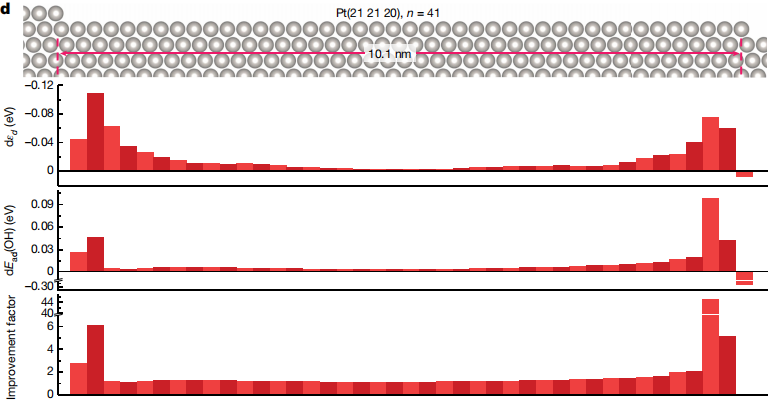Source: DeepTech
There are differences between any individual. As the German mathematician Gottfried Wilhelm Leibniz said, "There are no two identical leaves in the world".
Recently, in the field of heterogeneous electrocatalysis, the joint team from Hunan University, Purdue University in the United States and Leiden University in the Netherlands also made scientific discoveries similar to the above conclusions.
The researchers used the first principle calculation to conduct an in-depth exploration of the surface stress and surface strain of platinum (Pt) single crystals at the atomic level. They found that "there are no two reaction sites with the same activity in the world", that is, the activity driven by surface stress is specific.
The research group expanded the system to 10 times of the previous system, and calculated the surface stress and surface strain of the platinum step surface with the width of 1-10 nm. After comparison and observation, it is found that even small step defects can cause different surface stresses.
As shown in the figure below, the distribution map of active sites is similar to a cable bridge in terms of visual effect. Specifically, there is often a site with the highest activity, and then the activity will slowly decline.
 Fig. 1 Atomic site resolved electronic structure, surface reactivity and electrochemical oxygen reduction activity of stepped platinum (111) surface (source: Nature )
Fig. 1 Atomic site resolved electronic structure, surface reactivity and electrochemical oxygen reduction activity of stepped platinum (111) surface (source: Nature ) They also found that the redox activity of atoms around the steps was significantly higher than that of atoms in the center of the table. Moreover, the activity of the latter can reach 50 times of the former. Therefore, the researchers concluded that the ability of electrochemical oxygen reduction reaction can be controlled by changing the surface width or adjusting the external stress, thus affecting the overall activity of the catalyst.
The reviewer commented on the research: "The author focuses on the influence of the existence of monatomic steps on surface activity. Revealing and elaborating these influences will help to better define the approximation applied in computational modeling, which is crucial to achieving more accurate prediction capabilities."
At the same time, the reviewers believed that "the exploration of the effects driving the catalytic reaction rate to the atomic scale is as old as the research in the field of catalysis. Therefore, in this sense, the methods adopted by the authors are very valuable."
Prior to this study, discrete active site models have long been widely used to predict catalytic activity. The problem with this model is that there are significant "errors" and the root cause is unknown. This study provides the answer.
In addition, this study also provides a new idea for the design and application of heterogeneous catalysts. Specifically, in the previous cognition, the activity of catalyst was defined at a certain point or a certain type of atom, and this study found that the activity of catalyst was distributed at adjacent, large number of sites.
To better understand, Zeng Zhenhua, the co correspondent author of the paper and a scientist at Purdue University, said figuratively: "If we compare the site to a flower, we used to think that the activity of the catalyst existed in a flower. After this research, we found that the activity was in a cluster of flowers."
He pointed out that this is a new scientific discovery in this field for decades, and also provides a "change" in the concept of the catalytic field. Moreover, this research is the first time to deeply study stress release from the most basic driving force level.
 Figure 1 Zeng Zhenhua (Source: Zeng Zhenhua)
Figure 1 Zeng Zhenhua (Source: Zeng Zhenhua) After the publication of this paper, a scientist said to Dr. Zeng Zhenhua that after the retirement of Honorary Professor Nenad M. Markovic of Argonne National Laboratory in the United States, few other scholars in this field studied such a basic system in depth, and could also publish the findings in Nature On.
Zeng Zhenhua also believed that the research was "not the most basic, only more basic". In fact, the research has gone through nearly six years from theoretical prediction to experiment to the official publication of the paper.
Interestingly, in order to promote this research, Dr. Arthur J. Shih volunteered to do single crystal experiments in the research group of Professor Marc T.M. Koper of Leiden University in the Netherlands. With the joint efforts of four other postdoctoral candidates, he completed the electrochemical experiments needed to verify the theoretical research.
 Fig. 1 Relationship between stress release and surface strain of platinum (111) worktop (source: Nature )
Fig. 1 Relationship between stress release and surface strain of platinum (111) worktop (source: Nature ) This research was published by the research group in 2019 Science The main research object is the specific strain of atomic sites.
Zeng Zhenhua believes that this is an ongoing study. Along the solid "foundation" of the past and the present, the future will continue to build it higher and higher like building.
At present, Zeng Zhenhua is engaged in independent research in Purdue University. His research interests mainly include fuel cells and hydrogen production by electrolysis of water. Not only has it maintained close cooperation with GM, 3M, Toyota and Honda, but also some scientific research projects have been supported by the US Department of Energy.
Next, he and his team will continue to explore in depth in stress and strain research. In addition to basic research on single crystal systems, they also plan to promote the application of basic understanding in nanoparticles and nanosystems.
At present, Zeng Zhenhua's team is recruiting young scholars and students. Those who are interested in joining can contact directly by email( zeng46@purdue.edu )。
 reference material:
reference material: 1.Liu, G., Shih, A.J., Deng, H. et al. Site-specific reactivity of stepped Pt surfaces driven by stress release. Nature 626, 1005–1010 (2024). https://doi.org/10.1038/s41586-024-07090-z
2.Wang,L.,Zeng,Z. et al. Tunable intrinsic strain in two-dimensional transition metal electrocatalysts. Science 363,6429(2019). https://www.science.org/doi/10.1126/science.aat8051
Operation/typesetting: He Chenlong



















